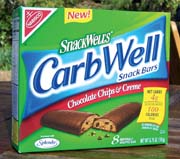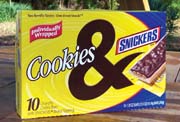
The market for cookies is quite large, $4.6 billion in sales, according to estimates in Mintel's (Chicago) market report “Cookies.” However, that sizable chunk has steadily deteriorated since 2002, with 2004's sales totals predicted to be a 6.4% fall from just two years ago and a lower sales level than 1999. Three factors are to blame.
First, the composition of the American household is changing. Children are the leading consumers of cookies; 97% of those under the age of 12 eat the treats, according to the Simmons (New York) 2003 Kids Survey. However, fewer of today's households have children present. As such, the category is adapting: sales of premium cookies, targeted primarily at adults, have increased sales steadily between 1999 and 2004, the period under review in Mintel's report.
Second, cookies are not considered healthful, on the whole, by consumers. Trans fatty acids, common in cookies and considered “bad” by consumers, must be listed beginning in 2005. Plus, the category's fare is not noted for its lack of sugar, fat or calories. This is important when considering the increased attention more Americans are paying to their eating habits, as the consequences of the long-term effects of obesity seep into the public's consciousness. Particular attention has been paid to childhood obesity and to the high-fat, sugar-rich foods consumed by the youth of America.
All of which dovetails rather nicely into the third major factor affecting cookie consumption: diets. The high-protein, low-carbohydrate efforts are of particular concern, considering sugar and refined grains in most cookies are a prime source of carbohydrates.
Mintel regards the combination of these factors as “potentially disastrous” for the cookie market and, indeed, the consequences can be seen already. Sales of standard cookies fell 5% from 2001 to 2003 and, perhaps even more telling, nearly 40% of adults in Mintel's exclusive consumer research say they are eating fewer cookie products than they were a year ago.
In response, major manufacturers have made efforts to take health and diet into account. Kraft Foods (Glenview, Ill.) has a global initiative to fight obesity with new products and consumer education, while the Keebler cookies line from Kellogg (Battle Creek, Mich.) added a low-carb line, although the company has announced recently that it is reducing the amount of fat in its Keebler cookies as well.

Each Unto His Own
For its part, Kraft has tried to bring the notion of portion control into the cookie arena. One of the company's 2004 launches was an Oreo 100-calorie pack, which also boasted no trans fat. Other 100-calorie cookie offerings are expected under the company's Back to Nature label.Attention to dietary concerns has benefited some companies. Murray Cookies' (Elmhurst, Ill.) sugar-free cookies increased sales from $97 million in 1999 to $118.6 million in 2003, according to Information Resources Inc. (IRI, Chicago). Not all have enjoyed success, though. Nabisco SnackWell's, repositioned as sugar-free because the fat-free trend was so last century, continue to see declining sales--dropping from $136.6 million in 1999 to $86.6 million in 2003. The simple answer for the decline could be consumers associating the products with their initial low-fat positioning. Regardless, a number of manufacturers now have pinned their hopes on the appeal of low-carb cookies to health-conscious consumers.
As Mintel implies, however, consumers may find it difficult to regard cookies as healthful. Furthermore, even if they can make such a leap of faith, do consumers want “healthful” from their cookies?
Growth of “healthful” cookies has leveled off in recent years, but Mintel believes the segment may be set to increase as a “plethora of low-carb and no trans fat cookies” enter the market. Sales of health-oriented cookies have increased 6% since 2001.
The burgeoning premium segment suggests that some consumers are willing to forego healthful for the occasional indulgence. While sales of standard cookies, which comprise 80% of the category's sales, have fallen in recent years, premium cookies have surged to command a 10% share of all cookies sold in 2004. These adult-targeted products do, however, fetch higher prices and include offerings from Pepperidge Farm (Norwalk, Conn.) and imports from such companies as Groupe Danone (Paris). In fact, cookie imports are on the rise themselves, rising by 41% from 2001 to 2003; Groupe Danone saw a 23% increase in sales of its LU brand in that time span.
Despite that growth, Kraft and Kellogg are the top two sellers of cookies in the U.S., combining for nearly 53% of the category's sales in 2003. Kraft alone netted more than 36% of sales in the market overall, 41% of sales in the standard cookie segment. The news has not been positive of late for these two companies, however. Kraft saw sales fall more than 3% from 2001 to 2003, while Kellogg's sales also dropped during that period, a fate shared by Parmalat USA (Wallington, N.J.) and McKee Foods (Collegedale, Tenn.).
For a Premium
Recognizing the dwindling base of households with children, a number of manufacturers have turned their attention to adults and have begun efforts to appeal to more complex tastes. Mintel finds there is an overall food trend toward indulgent ingredients in products primarily targeting adults. A small, yet growing segment of cookies serves as an example. Bistro New York International (New York) Café Biscuits are made with “high-quality” coffee and can be found in such flavors as Irish cream and French vanilla, and other offerings can be found featuring similarly indulgent ingredients, including Nabisco's Newton Caramel Apple Snackable Dessert Cookie.Such premium positioning is not relegated solely to the major manufacturers, however. Regular cookies are among the 20 top-selling store brand items, and more premium offerings can be found from private label. Kroger (Cincinnati) and Safeway (Pleasanton, Calif.) each feature a premium line, and Albertson's (Boise, Idaho) even has its own premium cookie brand--Essensia.
In addition to the private label challenge, major cookie manufacturers also face competition from in-store bakeries. ACNielsen (New York) finds that three quarters of all households shop at an in-store bakery, over a third doing so “often.” Items found there may give the impression of freshness or possibly fanciness, but one thing is certain: samples frequently entice the shopper. While packaged cookies do have the advantage of keeping better over time, this may be a drawback, as well, believes Mintel: consumers may not need to buy the items often.
Also contending with established cookie lines, albeit more of colleague than a challenger, are cookie bars. The most successful of these, in fact, have brought candy elements firmly into the cookie aisle. Keebler E.L. Fudge Butterfinger Blasted Butter-flavored sandwich cookies are made with Nestlé (Glendale, Calif.) Butterfinger candy. For the “Cookies &” line of cookie bars, Mars Inc.'s Masterfoods (Hackettstown, N.J.) borrowed some of its most popular confections, including Snickers, M&Ms and, recently, Twix, to create a popular line, one that saw sales nearly double to $47.9 million in 2003, according to Information Resources Inc.

Barred Exits
Such success for cookie bars could conceal a potential problem, surmises Mintel. With bars a rather blurred category, cookie bars could lead consumers to switch to a bar type that is not specifically a cookie bar. Cereal bars, for example, are quite similar to their cookie cousins, yet consumers may hold cereal bars in higher regard nutritionally. As Mintel observes, “Products like Quaker (Chicago) Chewy Cookies & Milk Granola Bars include flavors like chocolate mint cookie, chocolate chip cookie and cookie 'n cream…emphasize convenience, and their 'high-calcium' label promises nutrition, as well.”Ultimately, at present, cookie bars appear to have little effect on the category as a whole, accounting for only 3.5% of total sales. In fact, they could hold a benefit: they appeal to older teens and younger adults, a demographic that is not strong in cookie consumption, anyway. The bars do have an advantage in terms of convenience, but some recent introductions have endeavored to narrow that gap.
With cookies traditionally small and therefore convenient, those introductions have benefited primarily from packaging innovation, rather than formulation advancements. “Sharing packs” featuring resealable containers are an example. Such packaging holds another benefit for manufacturers: higher prices. A standard package of Chips Ahoy! (Nabisco) retails for about $3.39 for 16oz.; a 3.5oz. Chips Ahoy! Go-Pack fetches $1.49, while an 8oz. Mini Chips Ahoy! goes for $1.99.
Overall, however, standard cookies have faced declining sales and, considering the size of the segment, this has had a noticeable impact on the category's results. Total sales of all the other segments equaled only about 20% of 2004's cookie market, and Mintel predicts a near-future decline for the category. Sales in the standard cookie segment are expected to fall 15% through 2009, dragging the category into a 4% decline (16% at constant prices). Luckily for the category, expectations run a bit higher for the other segments. Premium cookies should continue to see rising sales, though at a smaller rate, increasing 29%. Meanwhile, health-oriented cookies and cookie bars can expect increases of 5% and 85%, respectively. The latter is expected to see sales begin to decline under the weight of limited interest and competition from other types of bar products.
That future, foresees Mintel, will have a cookie category still dominated by products tailored to children, though with more Hispanic products on offer, a nod to a noticeable demographic shift in the populace. Owing to the trend toward wellness, expect more health-oriented fare as well, as more organic, sugar-free, low-carb, etc., cookies hit the market. Mintel believes healthful positioning will be a more common theme, particularly in the wake of trans fat labeling requirements.
For more information on the report mentioned in this article, “Fish and Seafood,” contact Mintel International Group Ltd.; 213 W. Institute Place, Suite 208; Chicago, IL 60610; phone: 312-932-0400.
